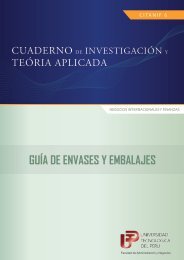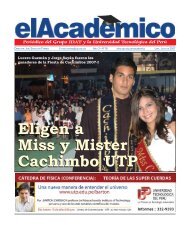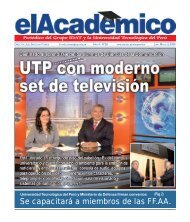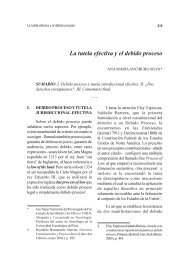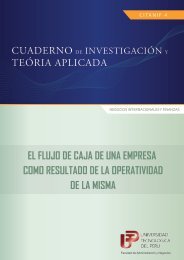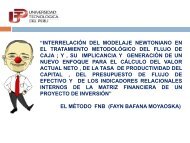Descargar - UTP
Descargar - UTP
Descargar - UTP
Create successful ePaper yourself
Turn your PDF publications into a flip-book with our unique Google optimized e-Paper software.
48<br />
an alternative way for communications system<br />
assessment. This work is structured as follows:<br />
In second part the usage of a I/O scheme is<br />
explained. A simple example is provided in order<br />
to test the validity of the problem. In third<br />
section the model is adapted to the problem of<br />
computing a PSCC spectrum by having welldefined<br />
input and transfer functions. In fourth<br />
section results are presented and finally conclusions<br />
regarding the results of this report are<br />
presented.<br />
II. WHY I/O?<br />
In linear control and system identification<br />
theory there is well-defined correspondence<br />
between I/O system elements through a<br />
transfer function or kernel (at the MIMO case,<br />
for instance). Mathematically speaking the<br />
realization of such correspondence is given by<br />
means integral equations and convolutions.<br />
In this framework, both I/O observables are<br />
described by determinism variables because<br />
the phenomenon involves determinism operators<br />
as well. This concept is exemplified by the<br />
master equation where the operator<br />
which performs the transition in<br />
the determinism manner. However, a similar<br />
picture would occurs in the case of using stochastic<br />
variables and parameters. If a variable<br />
transition is allowed, then under the I/O view<br />
the existence of a transfer function stochastic<br />
should encompass such action. For instance,<br />
if a PSCC is perceived as output, then would<br />
have to have its input associated function in<br />
the following way,<br />
(2)<br />
The function JK is expressed in its general<br />
form as a matrix. Under this scenario it is assumed<br />
the existence of several I/O functions<br />
as indicates us Eq. (2), and for the simple<br />
MIMO case, a one-to-one operation is required<br />
to model the PSCC uniquely. To validate this<br />
approach, a simple example is presented.<br />
A. A Simple Example<br />
The most simple case which would be used<br />
to extract an approximate PSCC curve would<br />
have to be the replacement of the transfer<br />
function by a delta function,<br />
returning a shape exactly like the PD because<br />
the effect in using a Delta function does<br />
not change the initial form on it. In reality for<br />
this simple case, one can test a Delta function<br />
with different argument which would make the<br />
departure from an ordinary one to one much<br />
more phenomenological,<br />
(3)<br />
resulting in a distribution that does not coincides<br />
with that of the P D necessarily. Contrarily<br />
to the trivial example as given in (3), to note<br />
now appears a quantity in (5). The resulting<br />
shape obtained in (5) is plotted in Fig. 1<br />
together to its input as well. In blue the PSCC<br />
curve is plotted against , whereas in red the<br />
P D one as a simple exponential. Clearly one observes<br />
that (5) satisfies a relation a SISO type.<br />
In order to be much more precise, one option<br />
would be the case where the transfer function<br />
argument depends on the difference<br />
It is because the basic definition at the Laplace space<br />
which is actually a linear relation between I/O.<br />
When is postulated a nonlinear one then one<br />
would expect an expression as Y (s) = G(s)X(s) +<br />
G 2 (s)X 2 (s) thereby providing a phenomenology at<br />
the nonlinear regime. Due to the stochastic nature<br />
of the phenomena a possible justification<br />
for using the I/O mechanism would consist in<br />
the incorporation of quadratic terms like Eq. (1)<br />
by keeping a certain coherence with the randomness<br />
of variables in the sense that stochastic<br />
would have its equivalence with nonlinearity.<br />
III. MODEL ADAPTATION FOR THE CASE<br />
OF THE PSCC<br />
A. Input Selection<br />
For the present analysis, we invoke to a simulation<br />
in order to built the corresponding input<br />
function namely the PDF function. We have<br />
appealed to an algorithm Monte-Carlo-like in<br />
order to generate the PDF curves. Instead of<br />
exponential profiles as commonly is derived<br />
from statistical foundations<br />
Fig. 1. PSCC versus curves with =0.5, from the usage<br />
of Eq. (5). In red is plotted the P D input function denoted<br />
by a simple exponential function whereas the blue one<br />
displays the Eq. 5. It is observed the correlation between<br />
I/O functions through the Eq. (4) by which a Delta function<br />
plays the role of a transfer function.<br />
CIENCIA, CULTURA Y TECNOLOGÍA - UNIVERSIDAD TECNOLÓGICA DEL PERÚ<br />
(6)<br />
(4)<br />
(5)





